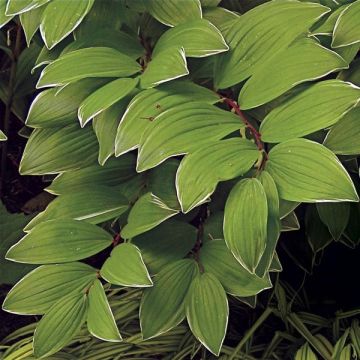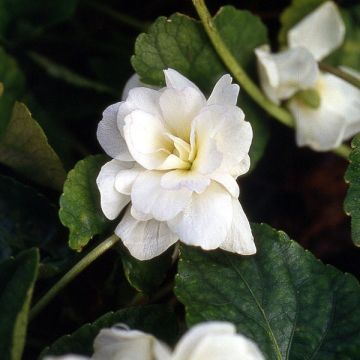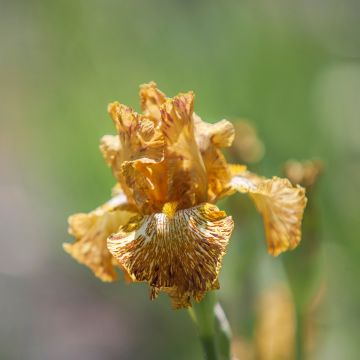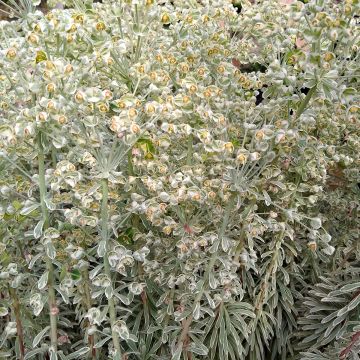

Polygonatum x hybridum Weihenstephan


Polygonatum x hybridum Weihenstephan
Polygonatum x hybridum Weihenstephan
Polygonatum x hybridum Weihenstephan
Sceau de Salomon
The plants are still in the ground and nothing is happening... so it's difficult to give a rating. Thank you for your customer service follow-up. Henri, retired.
Henri, 26/01/2025
This item cannot be shipped to the selected country
Delivery charge from €5.90
More information
Schedule delivery date,
and select date in basket
This plant carries a 12 months recovery warranty
More information
We guarantee the quality of our plants for a full growing cycle, and will replace at our expense any plant that fails to recover under normal climatic and planting conditions.
From €5.90 for pickup delivery and €6.90 for home delivery
Express home delivery from €8.90.

Does this plant fit my garden?
Set up your Plantfit profile →
Description
Polygonatum Weihenstephan is not only the most vigorous and spectacular of all Solomon's seals, but it has the good taste to keep a luxuriant appearance even in summer, when its little cousins have already surrendered to the heat. It is a superb shade or semi-shade perennial plant, easy to acclimatise in the garden or even in pots. In spring, it offers gracefully arching long leafy stems, with attractive pendulous cream-white bells that give way to decorative blue-black berries. Perfectly hardy and indifferent to the presence of roots in the soil, this plant spreads as a ground cover via its rootstock, dressing the base of hedges or the edge of a grove.
Polygonatum x hybridum (synonym x intermedium) belongs to the lily family (or asparagus family according to the classification). It is the result of a spontaneous cross-breeding between two species that populate our European undergrowth: Polygonatum officinale, the fragrant Solomon's seal, and P. multiflorum, the common Solomon's seal. 'Weihenstephan' is a very beautiful and even more vigorous German cultivar.
A herbaceous and perennial plant, it develops from a fleshy ochre-coloured rootstock and in spring produces upward-angled leafy stems, both erect and trailing, reaching an average height of 1 m (3 ft) (from 80 cm (32 in) to 1.2 m (4 ft) depending on the growing conditions). This Solomon's seal will eventually form colonies covering at least 1 m (3 ft) of ground. The foliage is deciduous, with ovate leaves arranged in two opposite rows. The lamina is a shiny dark green. The leaves measure 6 to 12 cm (2 to 5 in) in length; they are lanceolate-ovate in shape and have pronounced veins. The flowering period is from April to June depending on the climate, in the form of tubular flowers with a tender green top, 1 to 2 cm (0.4 to 1 in) long, solitary or in pairs, pendulous, and born in the axil of the leaves. This nectar-rich flowering is very popular with bees but devoid of fragrance. It is followed by spherical blue-black fruits, measuring 2 to 6 mm (0.1 to 0.2 in) in diameter. The plant only goes dormant with the arrival of autumn. Solomon's seal, like lily of the valley, is a very pretty but toxic plant, so beware of budding explorers visiting your gardens!
Graceful and yet robust, and often a little slow to establish itself, this 'Weihenstephan' Solomon's seal is nevertheless faithful, lives a long time, has very few requirements, and requires little care. It tolerates the competition from the roots of trees and shrubs in moist soil. It can be planted in the undergrowth or in dappled sunlight (introduce several plants in a small area), to accompany the spring blooms of Magnolia, Kolwizia, Deutzia, spireas, lilacs, or flowering cherries. In these beds at the base of shrubs, accompany it with Anemone 'Robinsoniana', Macleayas, Anemone Blanda, and golden-yellow buttercups. In nature, Solomon's seal easily grows alongside lily of the valley. Do the same and enhance this beautiful undergrowth scene by adding daffodils, snowdrops or snowflakes, as well as blue squills, which will take over.
The most common explanation for the name Solomon's seal comes from the appearance of the scars left on the rootstock once the flowering stems have dried, which resemble the six-pointed seal of King Solomon and King David. King Solomon is said to have also discovered the medicinal properties of Polygonatum. The distilled sap from the rootstock is still used in cosmetics today.
Report an error about the product description
Polygonatum x hybridum Weihenstephan in pictures


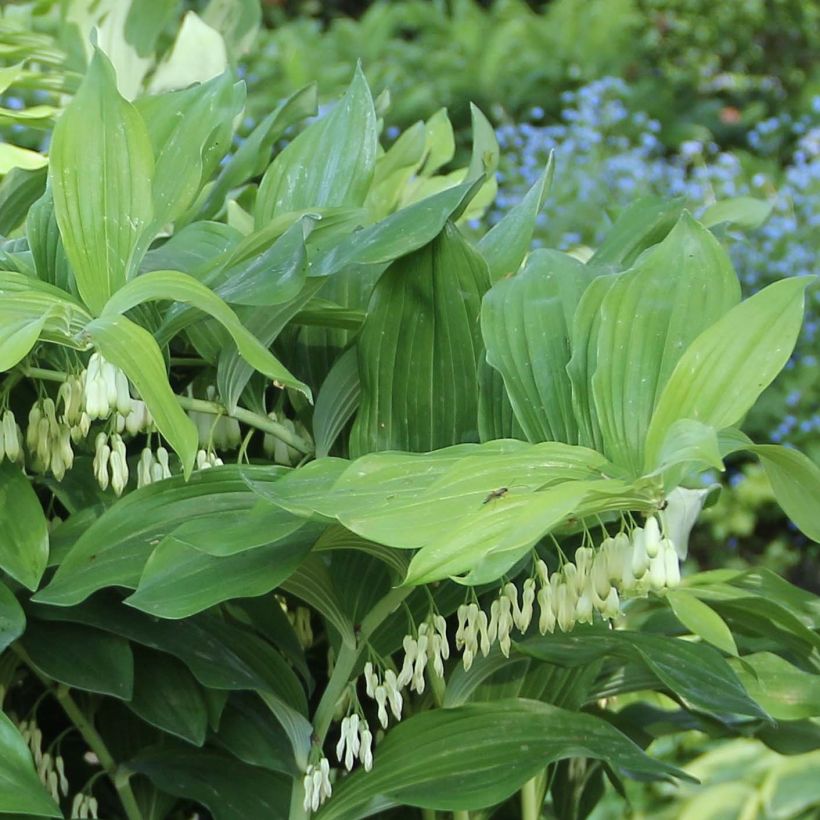



Flowering
Foliage
Plant habit
Botanical data
Polygonatum
x hybridum
Weihenstephan
Liliaceae (Asparagaceae)
Sceau de Salomon
Western Europe
Other Polygonatum - Solomon's Seal
Planting and care
Polygonatum Weihenstephan appreciates rich and light soils that are humus-rich like those found in the undergrowth, but shows a preference for soils with a tendency towards limestone. It also prefers well-drained soils that remain moist, although it is perfectly capable of coping with hot and relatively dry summers if it grows in deep and shaded soil. Install it from July to September in partial shade or not-too-dense shade. It is sometimes subject to attacks from gastropods and whiteflies. Divide the clumps in spring.
Planting period
Intended location
Care
-
, onOrder confirmed
Reply from on Promesse de fleurs
Spring flowering perennials
Haven't found what you were looking for?
Hardiness is the lowest winter temperature a plant can endure without suffering serious damage or even dying. However, hardiness is affected by location (a sheltered area, such as a patio), protection (winter cover) and soil type (hardiness is improved by well-drained soil).

Photo Sharing Terms & Conditions
In order to encourage gardeners to interact and share their experiences, Promesse de fleurs offers various media enabling content to be uploaded onto its Site - in particular via the ‘Photo sharing’ module.
The User agrees to refrain from:
- Posting any content that is illegal, prejudicial, insulting, racist, inciteful to hatred, revisionist, contrary to public decency, that infringes on privacy or on the privacy rights of third parties, in particular the publicity rights of persons and goods, intellectual property rights, or the right to privacy.
- Submitting content on behalf of a third party;
- Impersonate the identity of a third party and/or publish any personal information about a third party;
In general, the User undertakes to refrain from any unethical behaviour.
All Content (in particular text, comments, files, images, photos, videos, creative works, etc.), which may be subject to property or intellectual property rights, image or other private rights, shall remain the property of the User, subject to the limited rights granted by the terms of the licence granted by Promesse de fleurs as stated below. Users are at liberty to publish or not to publish such Content on the Site, notably via the ‘Photo Sharing’ facility, and accept that this Content shall be made public and freely accessible, notably on the Internet.
Users further acknowledge, undertake to have ,and guarantee that they hold all necessary rights and permissions to publish such material on the Site, in particular with regard to the legislation in force pertaining to any privacy, property, intellectual property, image, or contractual rights, or rights of any other nature. By publishing such Content on the Site, Users acknowledge accepting full liability as publishers of the Content within the meaning of the law, and grant Promesse de fleurs, free of charge, an inclusive, worldwide licence for the said Content for the entire duration of its publication, including all reproduction, representation, up/downloading, displaying, performing, transmission, and storage rights.
Users also grant permission for their name to be linked to the Content and accept that this link may not always be made available.
By engaging in posting material, Users consent to their Content becoming automatically accessible on the Internet, in particular on other sites and/or blogs and/or web pages of the Promesse de fleurs site, including in particular social pages and the Promesse de fleurs catalogue.
Users may secure the removal of entrusted content free of charge by issuing a simple request via our contact form.
The flowering period indicated on our website applies to countries and regions located in USDA zone 8 (France, the United Kingdom, Ireland, the Netherlands, etc.)
It will vary according to where you live:
- In zones 9 to 10 (Italy, Spain, Greece, etc.), flowering will occur about 2 to 4 weeks earlier.
- In zones 6 to 7 (Germany, Poland, Slovenia, and lower mountainous regions), flowering will be delayed by 2 to 3 weeks.
- In zone 5 (Central Europe, Scandinavia), blooming will be delayed by 3 to 5 weeks.
In temperate climates, pruning of spring-flowering shrubs (forsythia, spireas, etc.) should be done just after flowering.
Pruning of summer-flowering shrubs (Indian Lilac, Perovskia, etc.) can be done in winter or spring.
In cold regions as well as with frost-sensitive plants, avoid pruning too early when severe frosts may still occur.
The planting period indicated on our website applies to countries and regions located in USDA zone 8 (France, United Kingdom, Ireland, Netherlands).
It will vary according to where you live:
- In Mediterranean zones (Marseille, Madrid, Milan, etc.), autumn and winter are the best planting periods.
- In continental zones (Strasbourg, Munich, Vienna, etc.), delay planting by 2 to 3 weeks in spring and bring it forward by 2 to 4 weeks in autumn.
- In mountainous regions (the Alps, Pyrenees, Carpathians, etc.), it is best to plant in late spring (May-June) or late summer (August-September).
The harvesting period indicated on our website applies to countries and regions in USDA zone 8 (France, England, Ireland, the Netherlands).
In colder areas (Scandinavia, Poland, Austria...) fruit and vegetable harvests are likely to be delayed by 3-4 weeks.
In warmer areas (Italy, Spain, Greece, etc.), harvesting will probably take place earlier, depending on weather conditions.
The sowing periods indicated on our website apply to countries and regions within USDA Zone 8 (France, UK, Ireland, Netherlands).
In colder areas (Scandinavia, Poland, Austria...), delay any outdoor sowing by 3-4 weeks, or sow under glass.
In warmer climes (Italy, Spain, Greece, etc.), bring outdoor sowing forward by a few weeks.





































